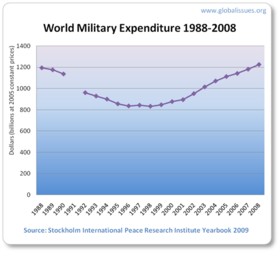Military Spending
This page is under review - Sameer
Description:
After declining in the post-cold war era of the early 1990s, global military spending has been on the rise again in the last decade. The United Nations is surprised at this continued rise in military spending — particularly at a time when the international community is grappling with a spreading financial crisis which threatens to undermine the poverty reduction goals of the world body. The global military spending is estimated at over US$1 trillion ($1.43 trillion),representing 2.4 per cent of world gross domestic product (GDP). Its level is now higher than during the latest Cold War peak in the 1980s.
Enablers:
- Increase in defense spending by the US on the war in Iraq and Afghanistan.
- Ambitions for global or regional power status
- Regional tensions or other national security concerns
- Armed conflict
- Policies to contribute to multilateral peacekeeping operations
- Internal political factors
- Exaggerated belief that political goals can be achieved by military means
- Global war on terror
- Availability of economic resources (especially for emerging economies like India and China)
Inhibitors:
- European Union
The EU has had an almost flat trend in military spending over the past 10-year period.
- major reduction in inter-state conflict
- Deals between the countries to limit the military spending
Paradigms:
There is a large gap between what countries are prepared to allocate for military means to provide security and maintain their global and regional power status, on the one hand, and to alleviate poverty and promote economic development, on the other. Even at a time when a deep economic recession is causing much turbulence in the civilian world … defense giants are enjoying a reliable and growing revenue stream from countries eager to increase their military might. In fact many countries have not cut military spending despite the crisis.
The main reason for the increase in world military spending is the massive increase in the United States, which accounts for almost half of the world total.... In the absence of [appropriations for the new war on terror, and on Iraq], US military expenditure would still show a significant increase, but at a much slower rate, and world military spending would show a rise of 4 per cent rather than 11 per cent in 2003. But it is not just the U.S. military spending. In fact, western militarism often overlaps with civilian functions affecting attitudes to militarism in general. As a result, when revelations come out that some Western militaries may have trained dictators and human rights violators, the justification given may be surprising.
Experts:
Jan Oberg US Department of Justice United Nations
Timing:
For most societies since the ancient civilizations, military exertions and the means by which to finance them have been the crucial issues of governance. Even for the Roman Empire, military spending was the largest item of public spending throughout its history. <br\> Since that time and especially in the 20th century, the size and spending of governments have increased. Even though the growth in welfare spending did somewhat abate in the late 1980s, it has been increasing again ever since. It is also unlikely that military spending will be displaced as a major spending item in national budgets. Various international threats and the lack of international cooperation will ensure that military spending will remain the main contender to social expenditures
Web Resources:
http://www.bt.com.bn/en/analysis/2009/09/13/military-spending-rises-undermines-peace <br\> http://www.globalissues.org/article/75/world-military-spending<br\> http://eh.net/encyclopedia/article/eloranta.military
